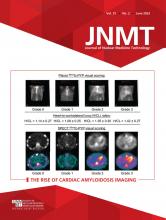Abstract
Myocardial perfusion imaging is primarily done to look for stress-induced perfusion defects in patients suspected of having coronary artery disease. However, the rotating raw images can provide significant information on the surrounding structures. The lungs lie near the heart, and any abnormality showing increased uptake can be seen on myocardial perfusion imaging. We report the case of a 52-y-old man with a history of diabetes for the previous 5 y, who presented to the cardiology outpatient department because of occasional chest pain and dyspnea. Electrocardiography and echocardiography showed no significant abnormality. The patient was referred to the nuclear medicine department for stress-induced myocardial perfusion scintigraphy. The raw 99mTc-sestamibi images showed abnormal uptake in the hilar region of the right lung, which, on subsequent investigations, was diagnosed as atypical bronchial carcinoid tumor.
Myocardial perfusion imaging (MPI) using SPECT continues to be an important noninvasive tool for clinicians to evaluate suspected or known coronary artery disease, often used in conjunction with other screening measures. However, in addition to the cardiac findings, extracardiac incidental findings can be seen on the rotating raw SPECT images or on the CT images when used for attenuation correction. There are case reports on such incidental findings during MPI. These findings may lead to an early diagnosis and to treatment of disease at an early stage. 99mTc-sestamibi uptake in lung cancer, breast cancer, lymphoma, peripheral soft-tissue cancer, and bone sarcoma, among others, has been reported in the literature but rarely is reported in carcinoid tumors (1,2). We present a case of atypical carcinoid incidentally detected on stress MPI.
CASE REPORT
A 52-y-old man with a history of diabetes for the previous 5 y presented to the cardiology outpatient department because of occasional midline chest pain and dyspnea. The physician ordered cardiac investigations including cardiac markers, electrocardiography, and echocardiography, which revealed no significant abnormality. Subsequently, stress MPI was advised to rule out inducible ischemia. The patient underwent an exercise stress test, and the raw images showed 99mTc-sestamibi uptake in the right hemithorax adjacent to the myocardial uptake (Figs. 1A and 1B). The unenhanced CT images, which were acquired for attenuation correction, showed a soft-tissue-density lesion near the right main bronchus (Fig. 1C). The patient underwent video bronchoscopy, which showed a growth at the right main bronchus occluding the lumen. The bronchoscopic biopsy sample at first was suggestive of a typical carcinoid tumor, and the patient underwent right upper lobectomy for the same. The final surgical histopathologic examination was suggestive of an atypical carcinoid tumor (Figs. 1D and 1E) involving the right main bronchus, without adjacent lung parenchymal invasion.
(A and B) SPECT images showing focal tracer uptake (arrows) in right hemithorax adjacent to myocardium: 3D SPECT image (A) and coronal section image (B). (C) SPECT/CT image showing tracer-avid intrabronchial soft-tissue-density lesion (arrow) in right main bronchus. (D) Hematoxylin and eosin–stained section showing respiratory epithelium. Tumor is seen in subepithelium (×200). (E) Hematoxylin and eosin–stained section showing tumor cells arranged in nests, rosettes, trabeculae, and cords (×400).
DISCUSSION
There are 3 main areas of origin for carcinoid tumors: foregut carcinoid tumors start in the lungs, bronchi, or stomach; midgut carcinoid tumors start in the small intestine, appendix, or proximal large bowel; and hindgut carcinoid tumors start in the distal colon or rectum. The appendix is the most common site of carcinoid tumors, followed by the rectum, ileum, lungs, bronchi, and stomach (3,4). The main treatment options include surgery, chemotherapy, and radiation with somatostatin analogs such as octreotide (Sandostatin; Novartis) or α-interferon. Importantly, the most common cause of carcinoid syndrome is metastatic liver disease arising from a small-bowel carcinoid tumor. For these patients, the prognosis is uniformly poor. Metaiodobenzylguanidine is a structural analog to norepinephrine, and 131I-labeled metaiodobenzylguanidine can be used for the detection of neuroendocrine tumors (5). However, the tumor is mostly asymptomatic, delaying the diagnosis. Incidentally diagnosed carcinoid tumors on 99mTc-sestamibi scans are rarely reported (1,2). In the present case, we had an incidental finding of atypical carcinoid tumor of the lung on rotating raw SPECT images of a patient undergoing MPI with 99mTc-sestamibi. These findings may lead to an early diagnosis requiring further treatment and a possibly improved prognosis for the patient. Therefore, careful evaluation of noncardiac findings is needed.
DISCLOSURE
No potential conflict of interest relevant to this article was reported.
Footnotes
Published online Oct. 4, 2022.
REFERENCES
- Received for publication June 10, 2022.
- Revision received September 16, 2022.








